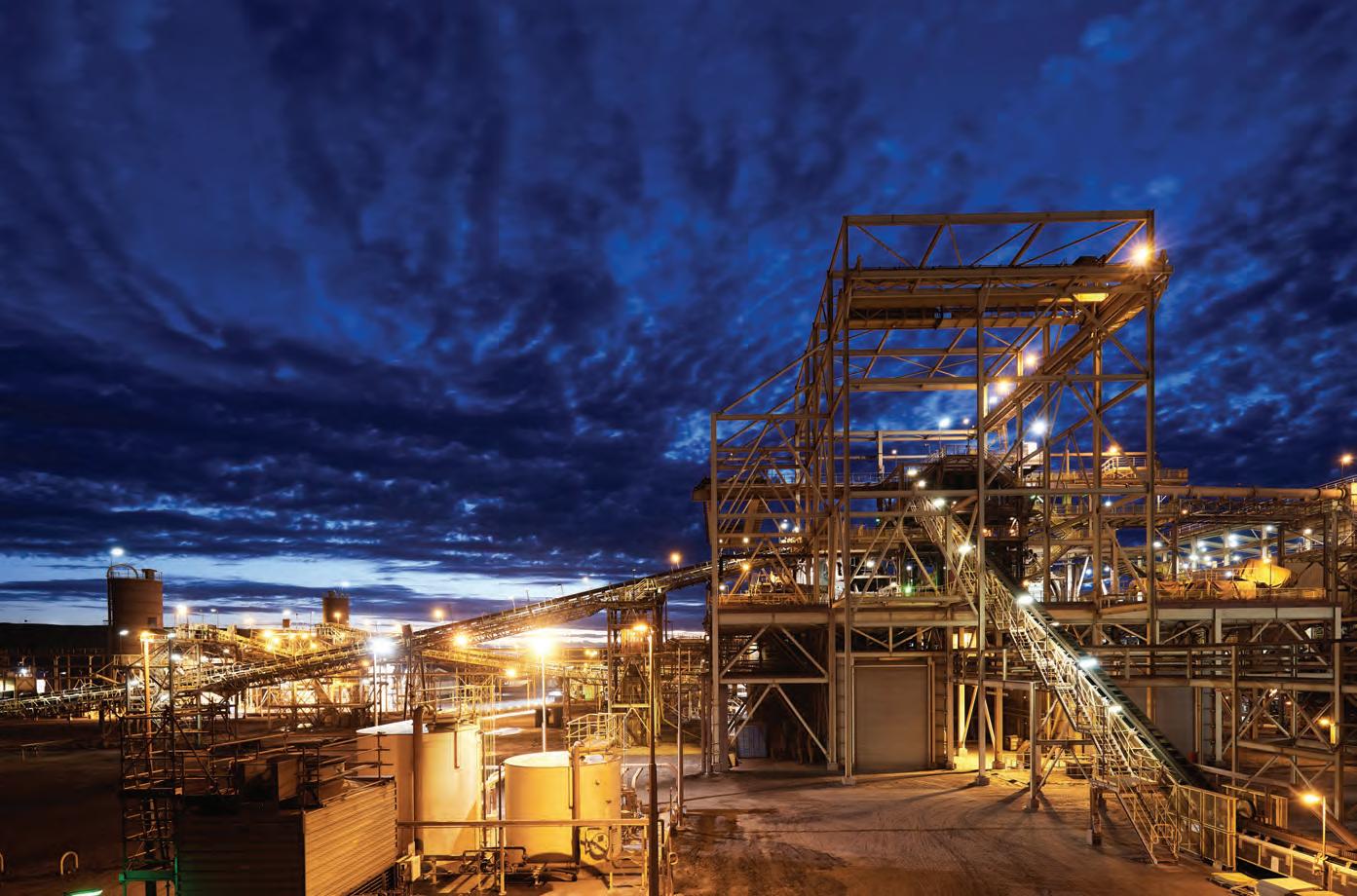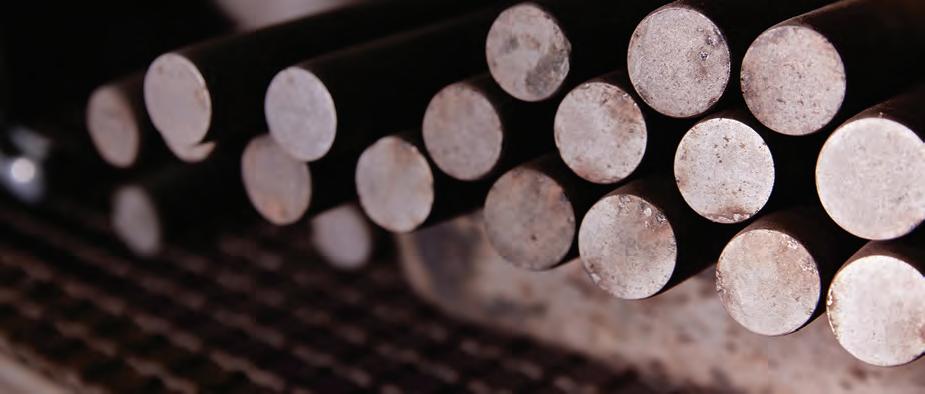
6 minute read
INDUSTRY OUTLOOK
COPPER COLLABORATION TO SAVE A PRECIOUS RESOURCE
OZ MINERALS’ PROMINENT HILL COPPER-GOLD MINE IN SOUTH AUSTRALIA. IMAGE: OZ MINERALS.
A NEW ROADMAP TOWARDS ZERO-EMISSION COPPER MINING HAS BEEN DEVELOPED THROUGH COLLABORATION IN THE MINING INDUSTRY. THE FIRST AVENUE TO ACHIEVE THIS INVOLVES WATER AND THE BOFFINS BEHIND THE ROADMAP ARE DEVELOPING THE TOOLS TO TACKLE IT. HENRY BALLARD WRITES.
While the volume of emissions from copper mining hardly compares with some more major commodities, the future of decarbonisation depends on the metal’s cleanliness.
Several reports from the International Copper Association Australia (ICAA) over the past 15 years have identified that copper demand is rising at rates never seen before.
BHP president of minerals for the Americas Ragnar Udd this year predicted copper demand will double in the next 30 years, with nickel to quadruple.
To tackle the decarbonisation of copper mining, the ICAA released a report in May 2020, called Zero Emission Copper Mine of the Future, in conjunction with the University of Sydney’s Warren Centre of Advanced Engineering.
The report details a roadmap towards decarbonised copper mining and five emission impact themes – discovery, material movement, ventilation, mineral processing and water.
Through a deep dive into each of these themes, the ICAA, its members and partners now look to develop a universal toolkit to provide current and future mine developers with the knowledge to achieve a universal goal – a zero-emission copper mine.
ICAA chief executive officer John Fennell explains the logistics of the toolkit.
“As we’re researching, we’ve been building a digital knowledge platform to provide an access point to chief technology officers, mine managers or mining executives as they find an issue in developing a new mine,” Fennell tells Australian Mining.
“The learnings that come from various research programs can be seamlessly added to this knowledge platform, so everyone is kept up to date.
“Then it’s up to industry to grab onto that and make it work. If they do it successfully, we’ll be able to identify some key technology challenges and breakthroughs which will allow industry to hasten the path towards zero emissions.”
And there are plenty of stakeholders on the path for their own reasons. Communities, miners and governments alike will benefit from the improvement of each of the five emission impact themes in their own ways.
But to give industry a place to dive into the concept, the ICAA believes there is no better theme to begin with than water.
More recently, the ICAA commissioned another report, called the Water Report, which provides a breadth of information on the role of water in copper mining and six key innovation themes to deal with the responsible use, reuse and reduction of water resources.
Clare Larkin Sykes, managing director of her namesake mining advisory, is a co-author on the Water Report and says this theme is as important as any due to its effects on everyone involved or nearby to copper mining.
“In a broad sense, many copper operations globally do operate in areas of high-water stress and this is likely to face increased pressures in the future,” Larkin Sykes says.
“These operations are also operating in a context of declining ore grades and deeper sulphide operations, which means that water and energy intensity is likely to increase.”
Larkin Sykes says water must be increasingly recognised as a precious resource and treated as such.
“There’s also a really strong social value on water in the regions where copper operations are likely to continue,” she says. “As a result, copper miners may face increased sensitivities in terms of the use and discharge of water.”
The ICAA approached several of its members to become involved in the Water Report, with Anglo American and Sandfire Resources taking an opportunity to sponsor the project.
Anglo American head of energy & storage Roland Berndt says the company was keen to build upon its strong platform of innovation.
“We were approached by the ICAA
at the end of 2020 and could see a good fit with the work we are already doing on reducing emissions at our operations,” Berndt says.
“We felt we were able to make a contribution and we were involved in both the executive steering committee and technical committee.”
The technical committee involved a second tier of mining and METS (mining, engineering, technology and services) companies, which could learn from each other and collaborate to develop new technologies to solve their collective copper mining issues.
OZ Minerals was one of many members on the technical committee. The company’s general manager of transformation Kate Hulmes says it was a terrific opportunity for an already innovative company.
“Being part of the technical management committee gave us a chance to learn from and share different experiences and learnings around technologies that have been tried in the past, and why they may or may not have succeeded,” Hulmes says.
“The workshops and the assessment of different catalyst pathways for partnerships and open innovation started to highlight the opportunities where OZ Minerals could lean in with other ICAA members to advance technology at pace.”
The six innovation impact themes of the Water Report are baseline measurement and mass water balance, dewatering, desalination, operation water use, tailings, and end use and reuse.
Larkin Sykes says one thing everyone learned from the Water Report is that no one company will be impacted by the findings in the same way.
“The theme we took from the
COPPER CAN BE USED IN A RANGE OF EXISTING AND FUTURE TECHNOLOGIES.
report and something we emphasised in the report is that no one pathway is applicable for every operation and each site will have its own roadmap to look holistically across the water usage and mining operations chain,” she says.
Fennell builds on this idea, adding that each step of the mining process must be considered and addressed on a case-by-case basis.
“When you set up a new mine, the key is to work out how much water is available in the area without impacting the local community and how long will that last,” he says.
“You’ve basically got to take little chunks out of your water use as you make your way through the mine development process.
“One little improvement in each section means you can just chip away for a still significant 20 to 30 per cent reduction before you make the grand leap toward zero-emission mining.”
Each company will of course tackle the chunks in different ways, owing to their business strategies, location, mining context or simply that there’s no single solution.
Berndt details some of the ways Anglo American is addressing water use in its operations.
“We are developing and implementing numerous processing and mining technologies that deliver improvements in water consumption and energy efficiency,” he says.
“Many of these have a theme of precision mining and early waste rejection, such as bulk ore sorting and coarse particle recovery, reducing the waste volumes produced, delivering lower energy and water intensity, and higher levels of water recycling.”
Anglo American has committed to increasing water recycling above 75 per cent and to reduce the abstraction of freshwater by 50 per cent by 2030.
OZ Minerals, alternatively, has been inspired to run its next Crowd Challenge – Waste to Value – in partnership with Amira (a resources sector not-for-profit) and the ICAA.
“Running in November this year, the Challenge invites mining companies and industry representatives to partner with us to explore a range of opportunities along the mining value chain that relate to waste minimisation and creating value from waste,” Hulmes says.
Ashley Brinson of Brinson & Associates is also a co-author on the Water Report. He hopes that once the ICAA’s toolkit for sustainable copper mining is complete, every company – not only the majors like OZ and Anglo American – can learn what they need and implement it where and when it’s applicable.
“Every site is different, this is very complicated, and there’s not a onesize-fits-all solution. Some copper mines are sulphide, some are oxide, some are open cut and some are underground,” Brinson says.
“But there’s a whole map there in the Water Report to help copper miners get from where they are today to this future point.” AM












